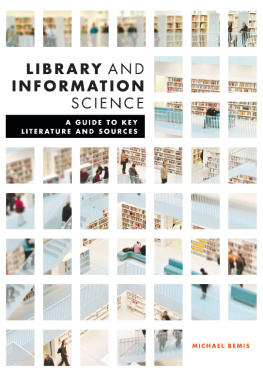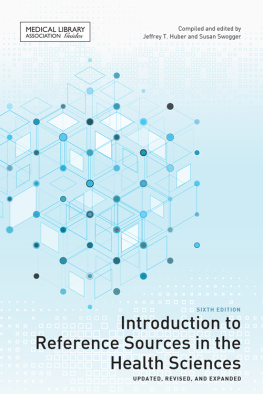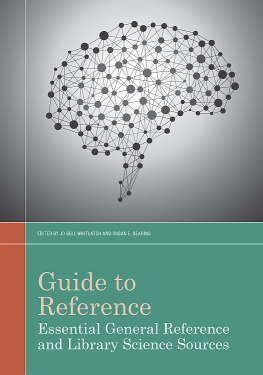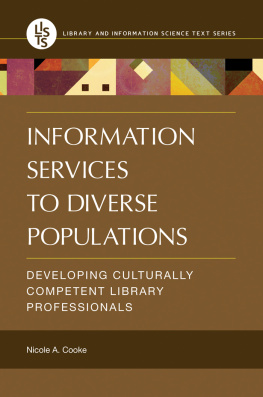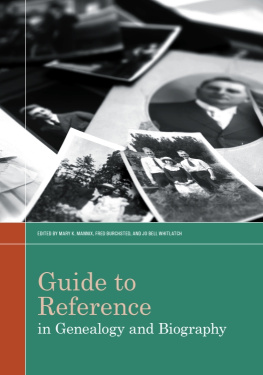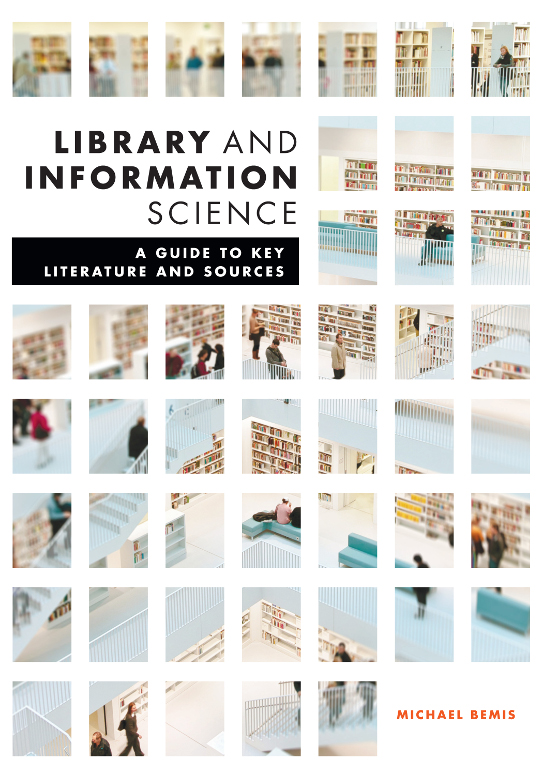
ALA Editions purchases fund advocacy, awareness, and accreditation programs for library professionals worldwide.
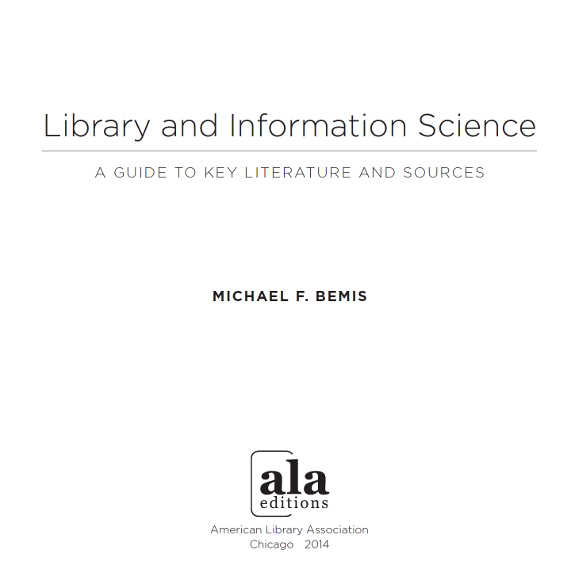
MICHAEL F. BEMIS has written reference book reviews for American Reference Books Annual, Library Journal, Reference and User Services Quarterly, and other professional librarian publications. He reviews book proposals for Praeger Press and is a member of the National Book Critics Circle. He holds an MLIS degree from St. Catherine University in St. Paul, Minnesota, and a BA in English from the University of St. Thomas, also in St. Paul. He recently completed a two-year term as chair of the Materials Reviewing Committee of the Reference and User Services Association.
2014 by the American Library Association. Any claim of copyright is subject to applicable limitations and exceptions, such as rights of fair use and library copying pursuant to Sections 107 and 108 of the U.S. Copyright Act. No copyright is claimed for content in the public domain, such as works of the U.S. government.
Extensive effort has gone into ensuring the reliability of the information in this book; however, the publisher makes no warranty, express or implied, with respect to the material contained herein.
ISBNs: 978-0-8389-1185-3 (paper); 978-0-8389-9604-1 (PDF); 978-0-8389-9605-8 (ePub); 978-0-8389-9606-5 (Kindle). For more information on digital formats, visit the ALA Store at alastore.ala.org and select eEditions.
Library of Congress Cataloging-in-Publication Data
Bemis, Michael F., 1956
Library and information science : a guide to key literature and sources / Michael F. Bemis.
pages cm
Includes bibliographical references and .
ISBN 978-0-8389-1185-3 (alk. paper)
1. Library scienceBibliography. 2. Information scienceBibliography. I. Title.
Z666.B38 2013
016.02dc23
2013005333
Cover design by Kimberly Thornton. Image Shutterstock, Inc.
To my colleagues, the librarians of the world, this work is respectfully dedicated.
Come, and take choice of all my library, and so beguile thy sorrow.
Shakespeare, Titus Andronicus, 4.1, 1594
CONTENTS
APPENDIX A
American Library Association Divisions, Chapters, and Affiliates
APPENDIX B
International and National Professional Associations
N o author can claim to create a work such as this singlehandedly. Many wonderful folks have invested their time and effort on my behalf, and I would like to express my appreciation for their contributions to the finished product you now hold before you. Any errors or omissions are my responsibility alone, but credit for a job well done is rightly shared among the following list.
To Jill Bemis, my loving and faithful wife of many years, for her organizational abilities and for keeping me on task. To Nathaniel Bemis, our son, for his encouragement and faith in the Old Man. To Jenni Fry of ALA Editions for her assistance with Endnote software. To Josh Hadro and Margaret Heilbrun at Library Journal for helping me to acquire review copies of LIS material. To Chris Rhodes, acquisitions editor at ALA Editions, for his initial interest in my book proposal and for his continuous encouragement, good cheer, and sage advice. To the entire staff at the St. Catherine University Library, St. Paul, Minnesota, for all the assistance they have lent me during the course of this project.
I would be remiss if I did not also make mention of the North Pole Restaurant in Newport, Minnesota, owned and operated by Mary, David, and Brian North. The many fine meals served by a friendly and efficient staff helped fuel long days and nights of plowing through library science literature.
I wrote this book for a simple reason: I needed a current annotated bibliography of library science but couldnt find one. My goals were twofold: to collect as much of the available information sources regarding various aspects of the profession as reasonably possible and to then organize them in a logical fashion. It is my fervent hope that my colleagues will find this to be a useful work as they conduct research in our field of endeavor.
Written specifically with working librarians in mind, this volume should also appeal to library students, library educators, and to a lesser extent bibliographers in general. Of course, anyone wishing to survey the current landscape of library literature should find this book helpful.
Books and print periodicals are the focus of this annotated bibliography. Electronic journals, websites, and databases also receive attention, but to a much lesser degree. Print works with a copyright date of 2000 to, generally, early 2012 make up the bulk of this volume, although some classic LIS titles are featured in special Historic Interest sidebars. A case in point is the one in , which discusses the ARBA Guide to Library Science Literature and its several annual supplements. Readers are directed to this resource should they desire to locate professional material for the period 1970 through 1999.
I enlisted OCLC WorldCat, local library collections within Minneapolis/St. Paul (most notably the LIS collection at the library of the College of St. Catherine, which supports a library school there), and review copies from publishers along with their websites and catalogs to find suitable material for inclusion in this volume. Emphasis is on usefulness and practicality for the working librarianthus the many how-to manuals, handbooks, and other materials that may be employed for on-the-job use.
ENTRIES
There are two types of entries herein. Full annotations include complete bibliographic information, such as title, author/editor, publisher, and date of publication, as well as ISBN or ISSN, as appropriate, and a URL for websites, along with commentary on the work at hand. Citations include just the bare-bones bibliographic data and are listed under the heading Further Resources. In either case, entries follow the provisions set forth in The Chicago Manual of Style, which for the past century has been widely regarded as the standard of manuscript preparation. The specific criteria I used to select a particular resource for either the full treatment or the more concise listing appear below. It should be noted that there were some resources reviewed that, in my professional opinion, met few or none of these standards and therefore were not listed at all. Fortunately, the level of quality of library literature is quite high overall.
Resources that met the following four criteria include full bibliographic data as well as commentary:
Timeliness of information. Reflects current trends, issues, or historical perspective.
Authority of resource or author qualifications. Clearly indicates who the author is, what organization(s) he or she is affiliated with, and if the work had sponsorships.
Professional standing. Is quoted widely and often cited in lists of references, bibliographies, or works cited in other resources examined during primary research. Primary and secondary sources were clearly listed.
Special features. Contains special features that are unusual or particularly helpful (e.g., tables, diagrams, step-by-step instructions, case studies, historical context).
Resources that did not merit annotation are nonetheless applicable to the specific chapter topic and provide supplementary or alternative information not covered by the annotated entries. A further benefit of listing these additional resources is that it allows for the inclusion of much more material and gives the reader a sense of where publishing activity is most prevalent. It probably comes as no surprise, for example, that the chapter covering information technology is one of the largest in this book.

